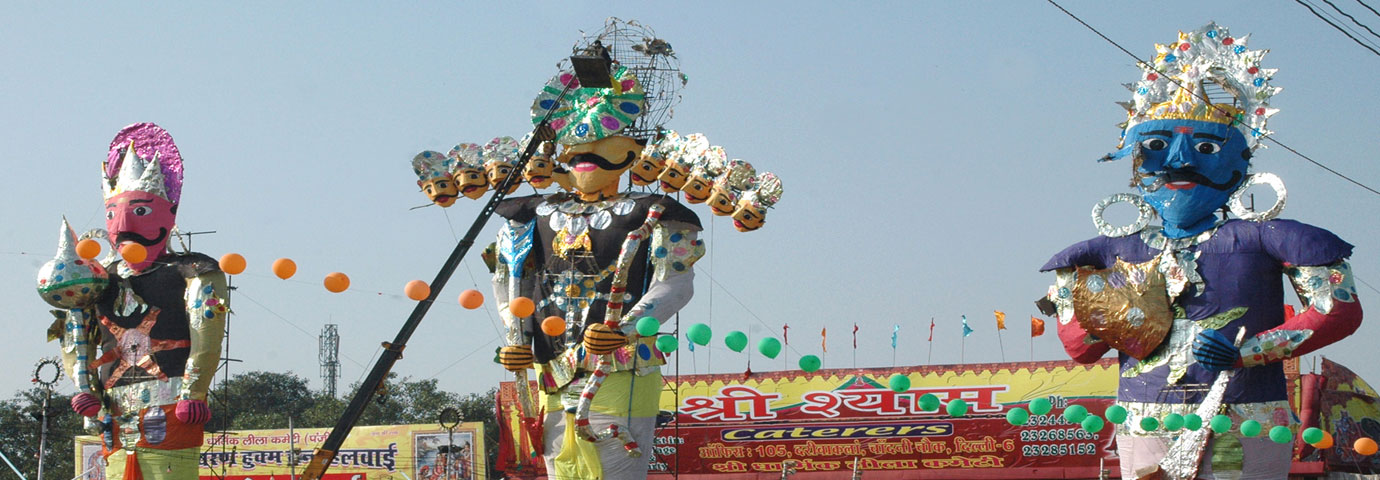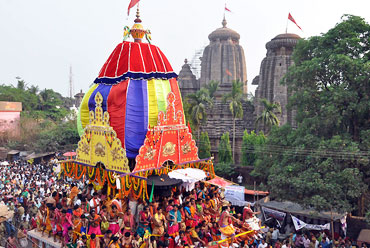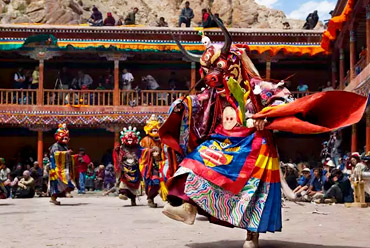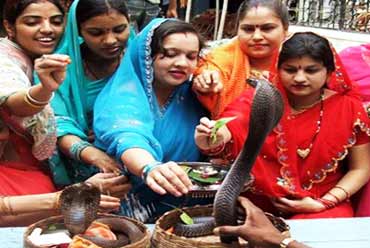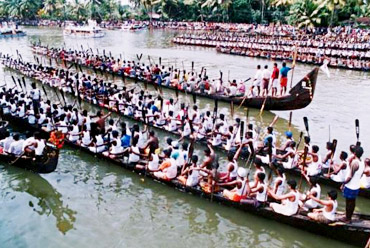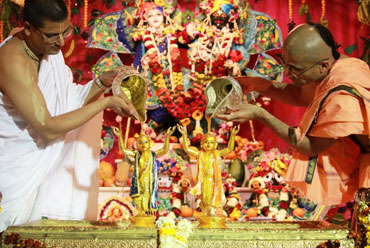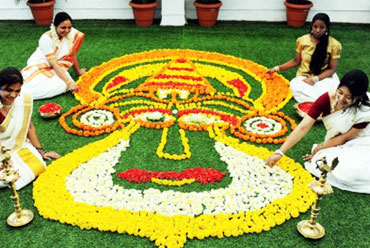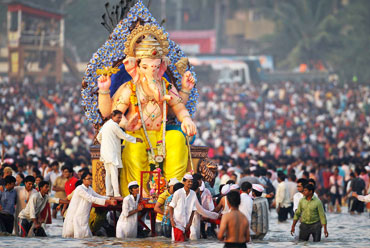One of the big festivals celebrated in most parts of India is Dussehra. The festival is celebrated with zest and festivities as it also marks the beginning of the winter season after the long, unbearable, hot summer. Dussehra marks the victory of Ram over the demon king Ravana, and the rescue of his wife Sita. In north India, gigantic effigies of the ten-headed Ravana and his brothers are set aflame amidst bursting of crackers. Fairs are usually held on this occasion with lots to eat, buy and enjoy.Dussehra means the Tenth Day, being the 10th day of the bright half of Ashvin. This day is also known as Vijayadashmi, or the Victory Tenth, because of the victory of Ram over Ravana.
Celebrations
Dussehra is one of the significant Hindu festivals, celebrated with much joy and happiness in the entire country. The occasion marks the triumph of Lord Ram over Ravana, the victory of good over evil. Brilliantly decorated tableaux and processions depicting various episodes from Ram's life are taken out. On the tenth day, or the Vijayadasami, colossal effigies of Ravana, his brother Kumbhkarna and son Meghnad are placed in vast open spaces. Actors dressed as Ram, his consort Sita, and brother Lakshman arrive and shoot arrows of fire at these effigies, which are stuffed with firecrackers. The result is a deafening blast, and an explosion of sound and light enhanced by the shouts of merriment and triumph of the spectators.
Also part of the celebration is the Ram Lila or the dramatic depiction of episodes from the lives of Ram, Sita, and Lakshman. All the regions across the country have evolved their own distinctive style, and performances at different places are done in the local language.
Rituals
As Dussehra is preceded by the Navratri or the nine days of the worship of Goddess Durga, some rituals related to the Goddess are also carried out that day. The rituals of Durga Puja involve the usual puja of goddess Durga along with Lord Ram.
Legends
On this day in Satyug, Ram (the eighth incarnation of Lord Vishnu), killed the great demon and king of Lanka, Ravan, who had abducted Ram's wife Sita. Ram, along, with his brother Lakshman, follower Hanuman, and an army of monkeys fought a great battle for ten days to rescue his wife Sita.
According to another story, Kautsa, the young son of Devdatt, a Brahmin, was living in the city of Paithan. After studying under the guidance of Rishi Varatantu, he insisted on his guru accepting a present, or gurudakshina. Initially the guru refused but later asked for 140 million gold coins, one hundred million for each of the subjects taught. The obedient student went to the King Raghu to ask for the money, as the king was renowned for his generosity. Within three days the king made the God of Wealth Kuber make a rain of gold coins near the shanu and apati trees. After giving the promised amount to the guru, Kautsa distributed the rest of the coins among the needy on the day of Dussehra. Even today, in Ayodhya, the capital of King Raghu, people loot the leaves of the apati trees and present to each other as sone or gold.In ancient times kings used the feast of Dussehra to cross the frontier and fight against their neighboring kingdoms. This border crossing is known as seema ollanghan and Dussehra marked the beginning of the war season.
This was also the day to worship the weapons. According to legend, Arjuna, one of the Pandav princes, hid his weapons in a shami tree when the Pandavs were banished into the forests. After one year he returned from the forest and on the day of Dussehra, he retrieved his weapons and worshipped them along with the shami tree. Hence the custom of worshipping weapons on this day started.
Regional Celebrations
In north India the Dussehra celebration includes the Ram Lila that consists of plays, recitations and music that recall the life of the legendary hero, Ram. In Delhi, many amateur troupes perform Ram Lila based on the epic story of Ramayana throughout the nine-day worship of Goddess Durga. On the tenth day, elaborate processions lead to the Ram Lila grounds where immense cracker-stuffed effigies of the demon Ravana and his brother and son explode to the cheers of thousands of spectators.
Kullu, a small town in Himachal Pradesh, is witness to unique Dussehra celebrations. Since the times of Maharaja Ranjit Singh, Dussehra celebrations here begin three days after they do in the rest of India. On the first day of the festival, the idol of Raghunathji is mounted on a splendid rath (chariot), and pulled from its permanent place in the Dholpur maidan to another part of the meadow. Before beginning the auspicious ceremony of pulling the rath, the descendants of Ranjit Singh circle it and pray.
On the second day, a Devta Durbar (Council of Gods) is held, with Raghunathji presiding. On the last day of the festival, the chariot of Raghunathji is drawn amidst fanfare to the banks of the river Beas. Here a pile of wood and grass is set on fire to symbolize the burning of Lanka and five animals-a crab, a cock, a fish, a buffalo and a male goat are sacrificed. The people then immerse themselves in revelry. Lugri, the traditional Kullu drink, flows by the gallon.
In Tamil Nadu, the first three days are dedicated to the worship of Lakshmi, Goddess of Wealth and Prosperity, the next three days to Saraswati, Goddess of Learning and arts and the last three days to Shakti (Durga). In Tamil Nadu, Andhra Pradesh and Karnataka, families decorate dolls (Bommai Kolu) and prepare an elaborate spread of lamps and flowers. Women traditionally exchange gifts of coconuts, clothes and sweets. Vijayadasami is also considered an auspicious occasion for children to commence their education in classical dance and music, and to pay homage to their teachers.
In Mysore, it is celebrated with a pomp and pageantry reminiscent of medieval times. In Bengal and other parts of eastern India, Dussehra is celebrated as Durga Puja. Devotees wear new clothes and celebrate with music, dance and drama. On the last day, images of the warrior goddess are taken out in procession and immersed in a river or the sea.
Places To Visit
Hinduism being the most widely followed religion of the country, most of the Hindu festivals are celebrated all over the country. Almost every part of the country has its own specific way of celebrating this day of victory of good over evil. Be it Delhi, Haryana, Kullu and Mysore, one is sure to find celebration and revelry combined with religious rituals on this day.

